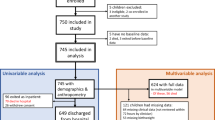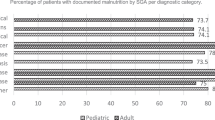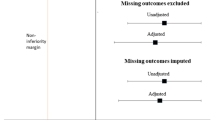Abstract
Background/Objectives:
To assesses how the introduction of new WHO discharge criteria for the treatment of severe acute malnutrition (SAM) may affect the performance of therapeutic feeding programmes in India.
Subjects/Methods:
The analysis concerns 6041 children admitted to Nutrition Rehabilitation Centers (NRCs) in Jharkhand, Madhya Pradesh and Uttar Pradesh between 1 July 2009 and 31 December 2011.
Results:
A total of 217 children (3.6%) had bilateral pitting oedema, 1803 (29.8%) had severe wasting with medical complications, 4021 (66.6%) had uncomplicated severe wasting and 4810 (79.7%) were in the age group 6–23 months old. The programme has high survival (>99%), default (⩾15%) and discharge (>75%) rates. The use of weight gain ⩾15% as recovery criteria (old criteria) translates into recovery rates in NRCs that range from 33.6% for children admitted with weight-for-height z-score (WHZ) ⩽−3 to 35.2% for children admitted with mid-upper-arm circumference (MUAC) <115 mm. The use of WHZ ⩾−2 as recovery criteria reduces recovery rates by ~2-fold (17.5%) while the use of MUAC ⩾125 mm as recovery criteria reduces recovery rates by 3.5-fold (10%). The new criteria tends to keep longer in the programme children who are younger and/or have poorer anthropometry at admission (that is, more vulnerable).
Conclusions:
The new WHO discharge criteria reduce the recovery rates currently reported by programmes for the treatment of children with SAM in India. However, their introduction in the programme practice will increase programme impact—particularly if accompanied by a general improvement in the strategy and protocols currently used—as they prioritize the most vulnerable children.
Similar content being viewed by others
Introduction
Severe acute malnutrition (SAM) is a threat to child survival as mortality rates in children with severe wasting are nine times higher.1 Globally, about 19 million children are severely wasted.2 With some eight million under fives severely wasted, India is at the epicenter of this crisis despite the country’s recent economic growth.3, 4
India’s response to SAM relies on a facility-based approach that provides care for children with SAM through a network of Nutrition Rehabilitation Centers (NRCs). In addition, a few states are piloting programmes where children with SAM are admitted to NRCs and later are transitioned to a community phase.
Children 6–59 months are admitted to these programmes, if they have (a) bilateral oedema; or (b) a weight-for-height z-score (WHZ) ⩽−3; or (c) a mid-upper-arm circumference (MUAC) <115 mm. Once admitted, children receive therapeutic care following the national guidelines by Ministry of Health,5 on the basis of those by the Indian Academy of Pediatrics6 and WHO.7
In line with national and international guidance, recovery rates in these programmes have been defined as the proportion of children gaining ⩾15% of their initial weight. However, analyses have reported that while these programmes achieve good survival outcomes, only a moderate proportion of children have recovered by the time of discharge.8, 9, 10
In 2013, WHO issued new global guidance indicating that percentage weight gain should not be used as discharge criterion. The revised guidance advises that children with SAM should be discharged when they have: (a) WHZ ⩾−2 and no oedema for at least 2 weeks; or (b) MUAC ⩾125 mm and no oedema for at least 2 weeks. The anthropometric indicator (MUAC or WHZ) used to confirm SAM at admission should be used to assess nutritional recovery.11
The objective of this analysis is to assess how the introduction of the new WHO discharge criteria for the treatment of SAM may affect the performance of therapeutic feeding programmes in India.
Materials and methods
This paper analyzes programme data on 6041 children 6–59 months old admitted to NRCs in Jharkhand, Madhya Pradesh and Uttar Pradesh (1 July 2009 to 31 December 2011) for whom programme records were complete. SAM was defined by the presence of bilateral pitting oedema or the presence of severe wasting.12 Severe wasting was defined as a MUAC <115 mm and/or WHZ ⩽−3 of the median WHZ in WHO Child Growth Standards.13
At the NRC, a physician conducted a clinical examination to detect the presence/absence of medical complications using the criteria for the Integrated Management of Neonatal and Childhood Illnesses.14 Children with bilateral pitting oedema, and/or medical complications and/or poor appetite were fed locally prepared F-75 therapeutic milk every 2 h for 2 days (stabilization phase) while their medical complications were treated. After completion of the initial 48 h in the NRC, children were fed locally prepared F-100 therapeutic milk six times a day for 48 h to initiate rapid weight gain (rehabilitation phase). Children free of oedema and medical complications with normal appetite entered the rehabilitation phase from admission. After 4 days at the NRC, children were fed locally prepared F-100 alternated with locally prepared semi-solid foods until discharge. All the children admitted to the NRC were administered age-appropriate preventive vitamin A, folic acid, zinc, potassium and magnesium and broad-spectrum antibiotics. Feeding, supplementation and care protocols have been described in detail elsewhere.8, 9, 10
Children were discharged when they met the following criteria: (1) the child was active and alert; (2) the child had no signs of oedema, fever and/or infection; (3) the child had completed all age-appropriate immunizations; (4) the child was fed at least 120–130 kcal/kg weight/day; (5) children had completed the prescribed 14-day stay in the NRC; and (6) the primary caregiver was informed about follow-up care.
In Madhya Pradesh, children were transitioned to the community phase of the programme where they were followed by the frontline workers of the state’s Integrated Child Development Services and National Rural Health Mission, who ensured that children benefitted from Integrated Child Development Services Supplementary Nutrition Program and returned for four follow-up visits at the NRC every 15 days. At each follow-up visit, children’s weight gain was assessed and mothers were counseled on child feeding and care.
Data collection procedures have been described in detail elsewhere.8, 9, 10 Analyses were performed using Stata Statistical Software, Release 12, 2011. Mean values are provided as mean±s.d. For all tests, P<0.05 was considered significant.
Findings
Of the children admitted, 3169 (52.5%) were girls, 3888 (64.3%) were from scheduled castes or scheduled tribes and 4810 (79.7%) were in the age group 6–23 months old. On admission, 217 (3.6%) had bilateral pitting oedema, 1803 (29.8%) had severe wasting with medical complications and 4021 (66.6%) had uncomplicated severe wasting (Table 1).
The following outcomes were recorded in the NRCs: Deaths: 30 children (0.5%) died after an average length of stay of 4.2±2.7 days. Defaulters: 1413 children (23.4%) defaulted after an average length of stay of 8.0±3.8 days. Discharged: 4598 children (76.1%) were discharged after an average length of stay of 15.3±2.7 days. Children’s average weight gain—determined as the total individual weight gain (after loss of oedema in the case of children who had oedema at admission) of all the children discharged divided by the total number of children discharged—was 9.3±14.8 g/kg body weight/day (Table 1).
A total of 3494 oedema-free children were admitted to NRCs with a MUAC <115 mm. At the time of discharge, 1229 (35.2%) had gained ⩾15% of their initial weight while only 349 (10%) had a MUAC ⩾125 mm. Multivariable logistic regression analysis indicates that the odds of recovery on the basis of a minimum 15% weight gain were higher among younger children (6–23 months old; odd ratio (OR)=1.36, 95% confidence interval (CI)=1.08–1.72) and children with poorer anthropometry at admission (that is, MUAC <115 mm and WHZ ⩽−3; OR=1.73, 95% CI=1.40–2.14) while the odds of recovery on the basis of an MUAC ⩾125 mm were higher among older children (24–59 months old; OR=1.44, 95% CI=1.19–1.74) and children with better anthropometry at admission (WHZ >−3; OR=1.85, 95% CI=1.59–2.16; Table 2).
Similarly, of the 3820 oedema-free children admitted with WHZ ⩽−3, 1282 (33.6%) had gained ⩾15% of their initial weight at discharge from the NRC while only 670 (17.5%) had a WHZ ⩾−2. The odds of recovery on the basis of a minimum 15% weight gain were higher among younger children (6–23 months old; OR=1.20, 95% CI=1.02–1.43) and children with poorer anthropometry at admission (WHZ ⩽−3 and MUAC <115 mm; OR=4.25, 95% CI=3.58–5.06), while the odds of recovery on the basis of WHZ ⩾−2 were higher among children with better anthropometry at admission (MUAC ⩾115 mm; OR=2.38, 95% CI=1.91–2.96; Table 2).
In Madhya Pradesh, 1914 children (72%) were discharged from the NRC after an average stay of 14.2±1.2 days and were transitioned to the community phase of the programme (Table 3). During the community phase, eight children (0.42%) died, 286 children (14.9%) defaulted and 1620 children (84.6%) were discharged after an average length of stay of 60±15.5 days with an average weight gain of 1.60±2.03 g/kg body weight/day.
A total of 1781 oedema-free children were admitted to the NRCs in Madhya Pradesh with a MUAC <115 mm. By the time they were discharged from the community phase, 1240 (69.6%) had gained ⩾15% of their initial weight whereas only 796 (44.7%) had an MUAC ⩾125 mm. The odds of recovery on the basis of a weight gain ⩾15% were higher among younger children (6–23 months old; OR=1.60, 95% CI=1.22–2.11) and children with poorer anthropometry at admission (MUAC <115 mm and WHZ ⩽−3) (OR=2.22, 95% CI=1.73–2.24) whereas the odds of recovery on the basis of MUAC ⩾125 mm were higher among children with better anthropometry at admission (WHZ >−3; OR=1.72, 95% CI=1.41–2.10; Table 4).
Similarly, of the 1941 oedema-free children admitted to the NRCs in Madhya Pradesh with WHZ ⩽−3, 1315 (67.7%) had gained ⩾15% of their initial weight when they were discharged from the community phase whereas only 1108 (57.1%) had a WHZ ⩾−2. The odds of recovery on the basis of a weight gain ⩾15% were higher among children with poorer anthropometry at admission (WHZ ⩽−3 and MUAC <115; OR=1.91, 95% CI=1.54–2.38). Recovery rates were not significantly different among children with poorer or better anthropometry at admission when the criteria used was WHZ ⩾−2 (Table 4).
Discussion
We used programme data on 6041 children 6–59 months old admitted to NRCs in Jharkhand, Madhya Pradesh and Uttar Pradesh to assess how the introduction of the new WHO discharge criteria for the treatment of SAM may affect the performance of therapeutic feeding programmes in India.
The proportion of children discharged from the facility- and community-based programmes (76.1 and 84.6%, respectively) is above minimum national/international standards (>75%).5,15 The average weight gain while in the NRC (9.3±14.8 g/kg body weight/day) is above the minimum 8 g/kg body weight/day recommended while the average weight gain while in the community phase (1.60±2.03 g/kg body weight/day) is below that observed in other settings (4–5 g//kg body weight/day)16 possibly indicating that the nutrient density of the foods used is substandard to ensure appropriate weight gain and timely recovery.
The use of WHZ ⩾−2 as recovery criteria (new criteria) translates into an ~2-fold reduction in recovery rates while in the NRC (from 33.6–17.5%) and a 1.2-fold reduction by the end of the community phase in Madhya Pradesh (from 67.7–57.1%). Similarly, the use of MUAC >125 mm as recovery criteria (new criteria) translates into a ~3.5 fold reduction in recovery rates while in the NRC (from 35.2–10.0%) and a 1.6-fold reduction by the end of the community phase in M. Pradesh (from 69.6–44.7%). Importantly, the old criteria tends to discharge sooner children who are younger (0–23 months old) and have poorer anthropometry at admission (i.e. more vulnerable) while the new criteria tends to keep them longer in the programme.
In conclusion, the new WHO discharge criteria reduce significantly the recovery rates currently reported by programmes for the treatment of children with SAM in India. However, their introduction in programme practice will increase programme impact as with the new WHO discharge criteria, the most vulnerable children (younger, with poorer anthropometry at admission, at a higher risk) tend to spend a longer time in the programme whereas the least vulnerable (older, with better anthropometry at admission, at a lower risk) tend to be discharged sooner.
The introduction of the new discharge criteria should be accompanied by improvements in the strategy and protocols currently used, with particular attention to: (1) Detecting children with SAM early—when they are young and less severely wasted, using MUAC <115 mm;12 (2) Admitting to NRCs only children with oedema/complicated wasting and keeping them in the NRC until oedema/complications disappear and weight gain starts, no longer; (3) Providing care for all children with uncomplicated SAM in the community; over 50 countries have adopted this approach;17 (4) Using therapeutic foods that meet the nutrient composition recommended by WHO; appropriate therapeutic foods for the management of SAM in the community are manufactured to international standards in India, and there is emerging consensus on how they should be used;18, 19, 20, 21, 22 (5) Discharging children on the basis of a minimum MUAC (⩾125 mm, for example) or minimum WHZ (>−2, for example), not on the basis of a minimum weight gain or minimum length of stay; and (6) Ensuring that children benefit from Integrated Child Development Services once they are discharged from the programme for the management of SAM.
References
Black RE, Allen LH, Bhutta ZA, Caulfield LE, de Onis M, Ezzati M et al. For the Maternal and Child Undernutrition Study Group. Maternal and child undernutrition: global and regional exposures and health consequences. Lancet 2008; 371: 243–260.
Black RE, Victora CG, Walker SP, Bhutta ZA, Christian P, de Onis M et al. Maternal and child undernutrition and overweight in low-income and middle-income countries. Lancet 2013; 382: 427–451.
United Nations Children’s Fund (UNICEF). Tracking progress on child and maternal nutrition. A survival and development priority. United Nations Children’s Fund (UNICEF): New York, NY, USA, 2009.
Chatterjee P . Child malnutrition rises in India despite economic boom. Lancet 2007; 369: 1417–1478.
Ministry of Health and Family Welfare. Operational guidelines on facility-based management of children with severe acute malnutrition. Government of India: New Delhi, India, 2011.
Indian Academy of Pediatrics. Indian Academy of Pediatrics 2006 guidelines for hospital-based management of severely malnourished children (adapted from WHO guidelines). Indian Pediatr 2007; 44: 443–461.
World Health Organization. Guidelines for the inpatient treatment of severely malnourished children. World Health Organization: Geneva, Switzerland, 2003.
Aguayo VM, Agarwal V, Agnani M, Agrawal D, Bhambhal S, Rawat A et al. Integrated program achieves good survival but moderate recovery rates among children with severe acute malnutrition in India. Am J Clin Nutr 2013; 98: 1335–1342.
Aguayo VM, Jacob S, Badgaiyan N, Chandra P, Kumar A, Singh K . Providing care for children with severe acute malnutrition in India: new evidence from Jharkhand. Public Health Nutrition 2014; 17: 206–211.
Singh K, Badgaiyan N, Ranjan A, Dixit HO, Kaushik A, Kushwaha KP et al. Management of children with severe acute malnutrition. Experience of Nutrition Rehabilitation Centers in Uttar Pradesh, India. Indian Pediatr 2014; 51: 21–25.
World Health Organization (WHO). Guideline: Updates on the Management of Severe Acute Malnutrition in Infants and Children. WHO: Geneva, Switzerland, 2013.
World Health Organization (WHO) and United Nations Children’s Fund (UNICEF). WHO Child Growth Standards and the Identification of Severe Acute Malnutrition in Infants and Children. A Joint Statement by WHO and UNICEF. WHO: Geneva, Switzerland, 2009.
World Health Organization (WHO). Multicenter Growth Reference Study Group. WHO child growth standards based on length/height, weight and age. Acta Pædiatr Suppl 2006; 450: 76–85.
World Health Organization (WHO). Technical Updates of the Guidelines on the Integrated Management of Childhood Illnesses (IMCI). Evidence and Recommendations for Future Adaptations. WHO: Geneva, Switzerland, 2005.
The Sphere Project. Humanitarian Charter and Minimum Standards in Humanitarian Response: 2011 Edition. Books for Change: Bangalore, India, 2011.
Collins S, Sadler K, Dent N, Khara T, Guerrero S, Myatt M et al. Key issues in the success of community-based management of severe malnutrition. Food and Nutrition Bulletin 2006; 27: S49–S82.
Field Exchange. Special focus on government experiences of community management of acute malnutrition (CMAM) scale up. Emergency Nutrition Network: Oxford, UK, 2012 Issue 43.
Kapil U . Ready to use therapeutic food in the management of severe acute malnutrition in India. Indian Pediatr 2009; 46: 381–382.
Sachdev HPS, Kapil U, Vir S . Consensus statement: National Consensus Workshop on Management of Severe Acute Malnutrition (SAM) through Medical Nutrition Therapy. Indian Pediatr 2010; 47: 661–665.
Prasad V, Sinha D, Sridhar S . Falling between two stools. Operational inconsistencies between ICDS and NRHM in the management of severe malnutrition. Indian Pediatr 2012; 49: 181–185.
Swaminathan MS . Undernutrition in infants and young children in India. A leadership agenda for action. In: Institute of Development Studies (IDS) Bulletin. Lifting the curse: Overcoming persistent undernutrition in India 2009; 40: 103–110.
Kapil U, Sachdev HPS . Management of children with severe acute malnutrition: a national priority. Indian Pediatr 2010; 47: 651–653.
Acknowledgements
This research received no specific grant from any funding agency in the commercial sector. The opinions expressed on this paper are those of the authors and do not necessarily represent an official position by UNICEF.
Author contributions
VMA designed the study, led data analysis and wrote the paper. NB led data management. KS contributed to data interpretation. All authors have read and approved the final manuscript.
Author information
Authors and Affiliations
Corresponding author
Ethics declarations
Competing interests
The authors declare no conflict of interest.
Rights and permissions
This work is licensed under a Creative Commons Attribution-NonCommercial-ShareAlike 4.0 International License. The images or other third party material in this article are included in the article’s Creative Commons license, unless indicated otherwise in the credit line; if the material is not included under the Creative Commons license, users will need to obtain permission from the license holder to reproduce the material. To view a copy of this license, visit http://creativecommons.org/licenses/by-nc-sa/4.0/
About this article
Cite this article
Aguayo, V., Badgaiyan, N. & Singh, K. How do the new WHO discharge criteria for the treatment of severe acute malnutrition affect the performance of therapeutic feeding programmes? New evidence from India. Eur J Clin Nutr 69, 509–513 (2015). https://doi.org/10.1038/ejcn.2014.197
Received:
Revised:
Accepted:
Published:
Issue Date:
DOI: https://doi.org/10.1038/ejcn.2014.197



